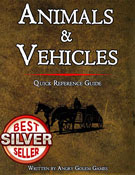Medium beast (animal), unaligned
Armor Class 12
Hit Points 5 (1d8+1)
Hit Points (suggested) 11 (2d8+2)
Speed 40 ft.
Proficiency Bonus +2
Proficiency Bonus +2 (5th Edition Advanced Mode)
| STR | DEX | CON | INT | WIS | CHA |
|---|---|---|---|---|---|
| 13 (+1) | 14 (+2) | 12 (+1) | 3 (-4) | 12 (+1) | 7 (-2) |
Skills Perception +3
Senses passive Perception 13
Challenge 1/8 (25 XP)
Keen Hearing and Smell. The mastiff has advantage on Wisdom (Perception) checks that rely on hearing or smell.
ACTIONS
- Bite. Melee Weapon Attack: +3 to hit, reach 5 ft., one target. Hit: (1d6 + 1) piercing damage. If the target is a creature, it must succeed on a DC 11 Strength saving throw or be knocked prone.
DESCRIPTION
A mastiff is a large and powerful dog that has a short coat of fur, usually brown or black in color. It has a broad head, a strong jaw, and a muscular body. Its ears are floppy and its tail is long and curved. A mastiff can grow up to 6 feet long and weigh up to 200 pounds. Mastiffs are loyal and intelligent animals that can be trained for various purposes. They have a keen sense of smell and hearing, which makes them excellent trackers and guards. They are also brave and fierce fighters, willing to defend their masters or companions from any threat.
COMBAT
A mastiff relies on its bite as its main weapon in combat. It can inflict serious wounds with its sharp teeth, and it can also knock down its prey or enemies with its strength. A mastiff has advantage on perception checks that rely on hearing or smell, which helps it detect hidden or stealthy foes. A mastiff can also be trained to obey commands from its master, such as attacking, guarding, or fetching. A mastiff can be ridden by small humanoids, such as halflings, as a mount. A mounted mastiff can move faster and maneuver better than a normal horse.
HABITAT / SOCIETY
Mastiffs are domesticated animals that live among humanoids, especially humans, dwarves, and halflings. They are often kept as pets, companions, or working animals. They can adapt to various environments, such as forests, hills, or urban areas. Mastiffs are social animals that form strong bonds with their masters and other mastiffs. They can communicate with each other through barks, growls, and body language. Mastiffs are loyal and obedient to their masters, but they can also be independent and stubborn at times. They need regular exercise and training to keep them healthy and happy.
ECOLOGY
Mastiffs are carnivorous animals that feed on meat, bones, and organs. They can hunt small animals, such as rabbits, squirrels, or rats, or scavenge leftovers from human settlements. They can also eat fruits and vegetables, but they prefer meat. Mastiffs need fresh water to drink and clean themselves. Mastiffs are not natural predators, but they can defend themselves from wild animals, such as wolves, bears, or lions. Mastiffs are not endangered species, but they can be affected by diseases, parasites, or injuries. Mastiffs can live up to 15 years in captivity.
Mastiffs can be used as mounts or pulling animals for vehicles.
The statistics are detailed in the D&D 5e Animals & Vehicles reference guide. Just have a look at the preview on DrivethruRpg.
